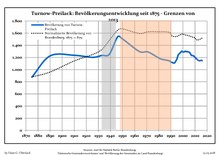Turnow-Preilack
Turnow-Preilack Turnow-Pśiłuk | |
|---|---|
Location of Turnow-Preilack within Spree-Neiße district  | |
| Coordinates: 51°52′00″N 14°24′00″E / 51.86667°N 14.40000°E | |
| Country | Germany |
| State | Brandenburg |
| District | Spree-Neiße |
| Municipal assoc. | Peitz |
| Subdivisions | 2 Ortsteile |
| Government | |
| • Mayor (2024–29) | René Sonke[1] |
| Area | |
• Total | 38.02 km2 (14.68 sq mi) |
| Elevation | 59 m (194 ft) |
| Population (2022-12-31)[2] | |
• Total | 1,103 |
| • Density | 29/km2 (75/sq mi) |
| Time zone | UTC+01:00 (CET) |
| • Summer (DST) | UTC+02:00 (CEST) |
| Postal codes | 03185 |
| Dialling codes | 035601 |
| Vehicle registration | SPN |
Turnow-Preilack (Lower Sorbian: Turnow-Pśiłuk) is a municipality in the district of Spree-Neiße, in Lower Lusatia, Brandenburg, Germany.
History
The municipality of Turnow-Preilack was formed on 31 December 2001 by merging the municipalities of Turnow and Preilack.
From 1815 to 1947, Turnow and Preilack were part of the Prussian Province of Brandenburg.
After World War II, Turnow and Preilack were incorporated into the State of Brandenburg from 1947 to 1952 and the Bezirk Cottbus of East Germany from 1952 to 1990. Since 1990, they have been part of Brandenburg, since 2001 united as the municipality of Turnow-Preilack.
Demography

|
|
|
References
- ^ Landkreis Spree-Neiße Wahl der Bürgermeisterin / des Bürgermeisters. Retrieved 10 July 2024.
- ^ "Bevölkerungsentwicklung und Bevölkerungsstandim Land Brandenburg Dezember 2022" (PDF). Amt für Statistik Berlin-Brandenburg (in German). June 2023.
- ^ Detailed data sources are to be found in the Wikimedia Commons.Population Projection Brandenburg at Wikimedia Commons




